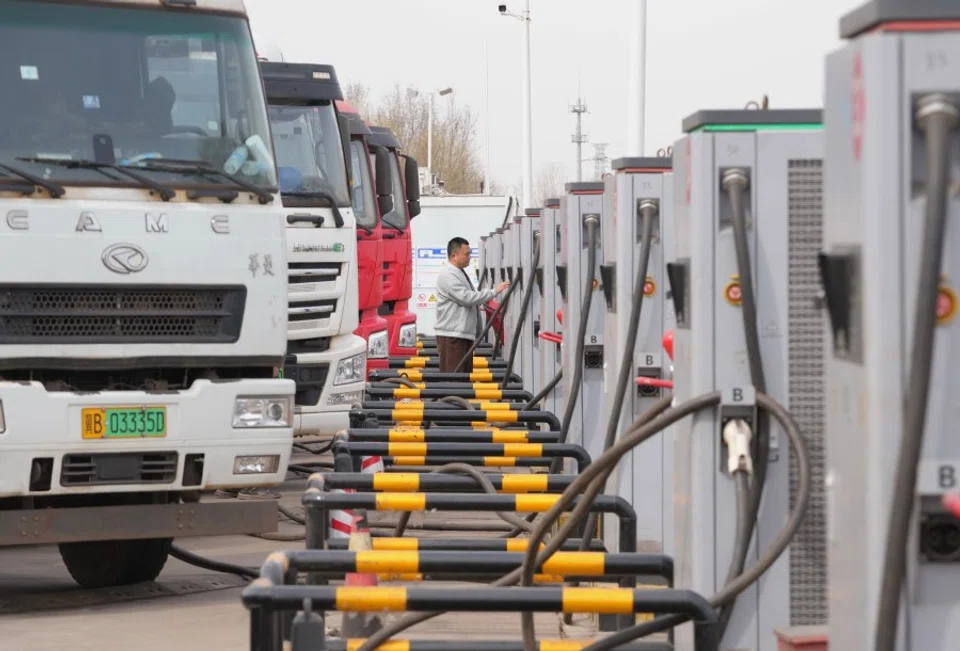Many challenges ahead as China promotes green hydrogen vehicles
The Chinese government has set targets for hydrogen-powered vehicles and diverse uses of hydrogen until 2035 as part of its push to get industries to shift to clean energy. However, given the processes and costs involved, it remains to be seen whether the initiative will gather enough momentum.

According to figures from the China Association of Automobile Manufacturers, there are over 10,379 hydrogen-powered vehicles in China - 9,000 units as of the end of 2021 and 1,379 units sold in the first half of 2022 - accounting for about 17% of the global total.
A hydrogen-powered vehicle produces electricity through an electrochemical reaction between hydrogen gas (H) in a fuel cell, and oxygen (O) from the surrounding air. Its biggest advantage is that steam or water (H2O) rather than carbon dioxide is produced, which makes it more effective than fossil fuels in reducing air pollution and mitigating the impact of climate warming.
China's three-step plan
In April 2022, China's National Development and Reform Commission and National Energy Administration released a mid- to long-term plan for the hydrogen energy industry from 2021 to 2035, confirming that hydrogen is an important part of the national energy framework. Indeed, China wants to make full use of the clean, low-carbon nature of hydrogen to push end users such as the transport and industrial sectors as well as high-energy, high-emissions industries, to transition to green, low-carbon operations.
China has a three-step plan to promote hydrogen vehicles. Step one, by 2025 China's hydrogen energy sector should have a fundamental grasp of core technology and production, and have about 50,000 hydrogen fuel cell vehicles in operation. In addition, China aims to build more charging stations and to produce 100,000-200,000 tonnes a year of renewable hydrogen, thus reducing the country's carbon emissions by one to two million tonnes a year.

Step two, build a more comprehensive technological innovation framework for the hydrogen energy industry and a clean energy hydrogen production and supply system by 2030, thus providing strong support for its peak carbon emissions goal.
Step three, have one million hydrogen-powered vehicles on the road and to build an ecosystem for diverse uses of hydrogen by 2035, with renewable hydrogen accounting for a significantly higher proportion of end-user energy consumption. And by 2050, China aims to achieve net-zero carbon emissions for vehicles alongside pure electricity technology.
These plans show China's ambitions in using hydrogen energy and developing hydrogen vehicles. To meet these targets, some basic issues and ideas need to be ironed out, while the technology and market also need to synchronise smoothly. Furthermore, there also needs to be an impetus to develop hydrogen vehicles.
Developing green hydrogen
At present, hydrogen vehicles in China mainly use hydrogen fuel cells. While they can be considered clean energy in terms of usage and emissions, their production may be otherwise. Hydrogen is secondary energy that does not occur naturally in abundance like oil and natural gas, so it has to be produced through other energy sources.
Based on its source, production technology and process, hydrogen can be categorised as grey (high carbon emissions through production using fossil fuels such as coal), blue (some carbon emissions are captured during production), or green (zero carbon emissions, or a clean process cycle from production to usage).
There will also be some energy losses in the production process, as the extraction of hydrogen from fossil fuels or other sources and its transformation back to energy is not 100% efficient.
China currently produces about 30 million tonnes of hydrogen annually, and almost all of it comes from non-renewable sources such as coal and natural gas...

Only green hydrogen can be considered environmentally friendly, which involves producing hydrogen by electrolysing water with clean energy sources such as hydropower, wind power or photovoltaic solar power. China currently produces about 30 million tonnes of hydrogen annually, and almost all of it comes from non-renewable sources such as coal and natural gas, while the cost of producing hydrogen is almost the same as using petrol and oil, which puts it in a grey hydrogen era.
The development of hydrogen-powered vehicles in China and around the world is not considered clean energy if only grey or blue hydrogen is used. Only when hydrogen is produced from clean energy alone can it be considered green and environmentally friendly - there is still a long way to go to achieve this goal.
More R&D needed
Notwithstanding, hydrogen-powered vehicles can still be developed and used at the current stage - even if it is grey hydrogen used to power cars - as it is already a move away from using fossil fuels. However, several issues need to be addressed in the development of hydrogen-powered vehicles, such as the regulations, policies, technologies, markets and infrastructure involved.
One, the safety of hydrogen fuel cells must be ensured before moving into large-scale production and wider use, to avoid a similar situation as electric vehicles (EVs), whereby their lithium-ion batteries could burst into flames and cause injuries and fires. Two, the engine of hydrogen fuel cells must reach a certain standard of structural safety and have a service life of 5,000 to 10,000 hours to meet the demand of vehicles.
... excluding land costs, it is ten times more expensive to build a hydrogen refuelling station than it is to build an EV charging station of the same size.

Three, after deducting government subsidies, the price of hydrogen fuel cell vehicles should be on par with fuel vehicles or lithium-ion battery-powered EVs. Four, hydrogen fuel supply should be sufficient and affordable. Five, hydrogen refuelling stations should be conveniently located for users to easily fill up their tanks.
The fifth point alone is difficult to achieve, due to the high costs involved in building hydrogen refuelling stations. Similarly, EVs are currently still far less popular than fuel vehicles due to the lack of charging stations.
China's report on the development of the hydrogen fuel industry (2020) (《中国氢能产业发展报告(2020)》) showed that excluding land costs, it is ten times more expensive to build a hydrogen refuelling station than it is to build an EV charging station of the same size. Hence, there are only about 270 hydrogen refuelling stations in China as of June 2022.
In addition, as hydrogen fuel cells have a low volumetric energy density, it takes up more vehicle space, thus making it more suitable for commercial vehicles such as large passenger cars or medium- and heavy-duty trucks or buses travelling long distances or fixed routes. It is still difficult to build into small vehicles.
In China, commercial vehicles (trucks and buses) are the main types of vehicles that use hydrogen fuel cells over the past five years, and the industry is backed by government subsidies.
Indeed, these factors limit the production, sale and popularisation of hydrogen fuel-cell vehicles. Although China is among the key countries after South Korea, the US and Japan to successfully promote the use of hydrogen fuel-cell vehicles, it still lags behind in terms of development speed and application.
Government support crucial
In China, commercial vehicles (trucks and buses) are the main types of vehicles that use hydrogen fuel cells over the past five years, and the industry is backed by government subsidies. As government subsidies for new energy vehicles pivot towards hydrogen fuel-cell vehicles, the sector is set to receive far more subsidies than pure electric and plug-in hybrid EVs.

With better policies and accelerated technology development and innovation, China's hydrogen fuel-cell vehicles are expected to scale greater heights. In 2017, China released the first industry standard guideline for the hydrogen industry - "Proton exchange membrane fuel cell modules for road vehicles".
In February 2021, China's Ministry of Science and Technology released a circular "soliciting opinions on the 2021 project application guidelines for 18 key special projects including the 'Hydrogen Energy Technology' in 'The 14th Five-Year Plan' National Key R&D Program".
The document proposes a focus on the four technical directions of green hydrogen production and large-scale transfer system; safe hydrogen storage and rapid hydrogen distribution and delivery system; convenient hydrogen upgrading and a high-efficiency power system; and a comprehensive demonstration of "bringing hydrogen into ten thousand homes".
This also means that China should accelerate the technological innovation of proton exchange membrane fuel cells and continue to improve the environmental friendliness, safety, stability and durability of hydrogen fuel cells.
If new breakthroughs can be achieved in green hydrogen production and storage; the process control system of hydrogen refuelling stations; and hydrogen fuel cell engines, China could usher in a new clean and green era that fully uses hydrogen fuel-cell vehicles.



![[Photos] Fact versus fiction: The portrayal of WWII anti-Japanese martyrs in Taiwan](https://cassette.sphdigital.com.sg/image/thinkchina/3494f8bd481870f7c65b881fd21a3fd733f573f23232376e39c532a2c7593cbc)

